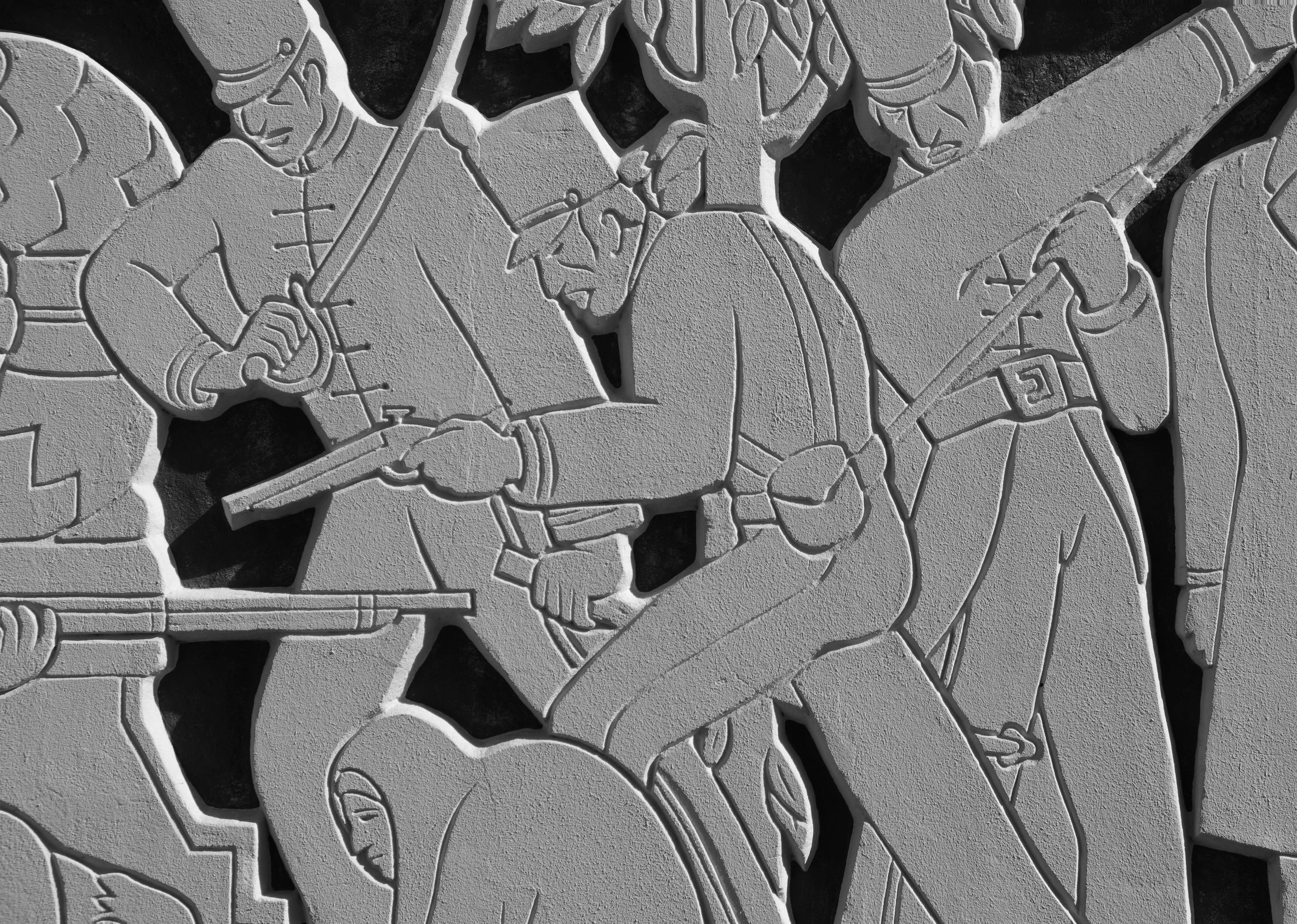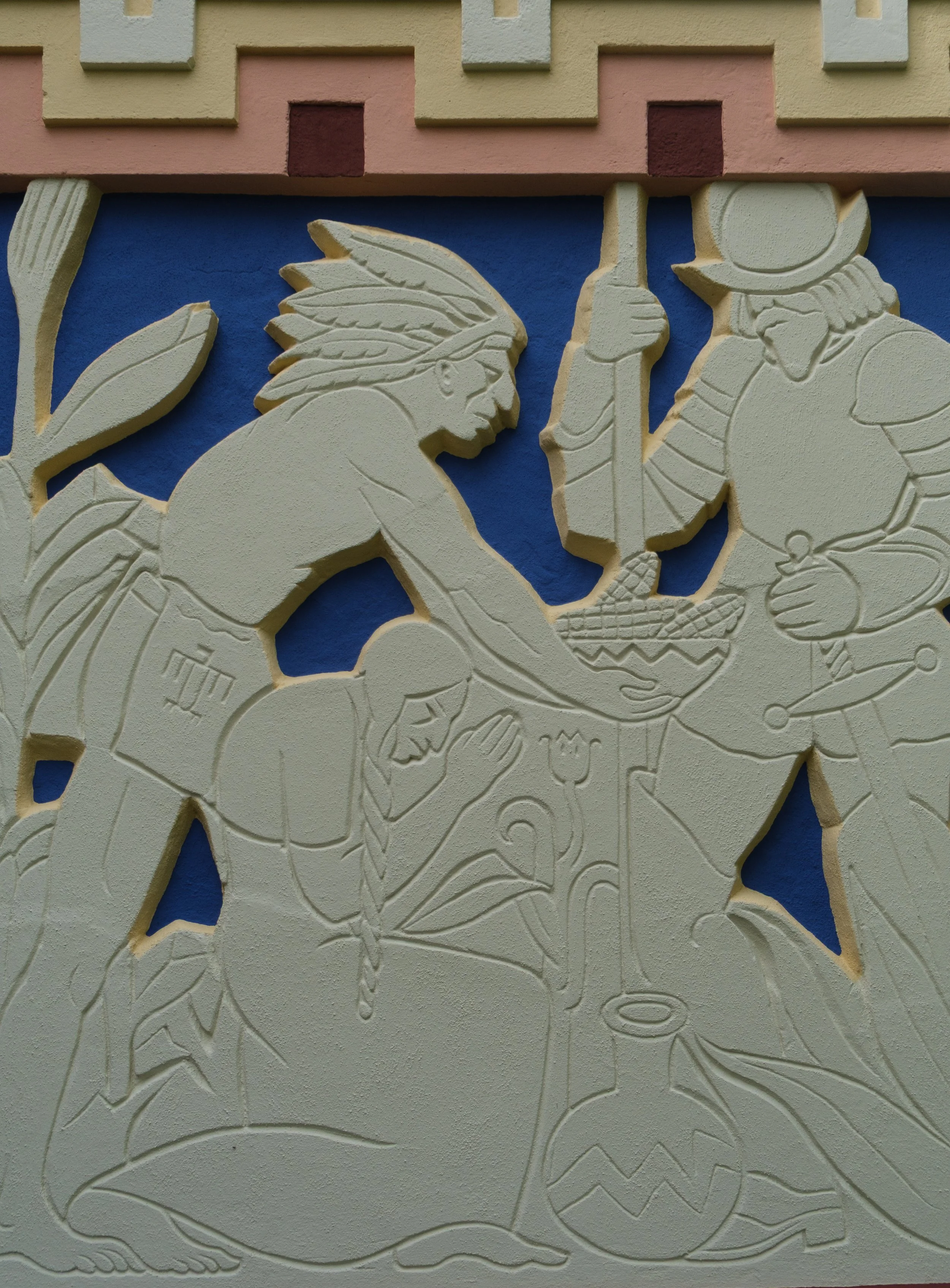Puzzling Layers of a Tale
How History is Told
March 17, 2025
Detail of Tower Building Frieze depicting a slice of Texas history.
It was Texas-sized ambition, or perhaps hubris, to present a slice of Texas’ giant history on a 170-foot-long sculptural frieze on the United States Building at the 1936 Texas Centennial Exposition.
But the 1936 Centennial Exposition was an audacious undertaking, and the organizers didn’t rein in their ambitions when making what is now known as the Tower Building Frieze.
With more than 100 figures, the frieze includes depictions of early meetings between 16th-century conquistadors and indigenous people, arrival of European clergy, battles between Texas soldiers and the Mexican army, and the founding of the Republic (1836) and its subsequent annexation (1845) to the United States.
The men instrumental in the state’s official story are sculpted there and they had names and titles – Coronado, Hidalgo, Austin, Houston – and they were immortalized in historical records. The work of artists made their likenesses familiar.
But who are the unnamed people shown interacting with these men and what do their roles symbolize?
There are the 16th-century Tejas natives (left), in postures of giving and reverence, presenting the Spanish explorer Francisco Vázquez de Coronado with corn, one of the natives’ most prized and revered bounty.
Coronado and his fellow Spanish explorers had gold fever as they searched in vain for the Seven Cities of Cibola, a mythical land of gold. A gift of golden corn may not have been what Coronado had in mind. Regardless, the arrival of the Spaniards set off a cruel chain reaction that changed the natives' existence forever.
A depiction of an “Indian Maiden” being presented with a cross by Father Hidalgo and other Franciscan monks, suggests a more complex story (image on right). Hidalgo and the other Franciscans were establishing missions to convert the Caddo and Tejas natives to Christianity.
But there are other men looking down on her – one being the French explorer LaSalle (far left) who founded a colony in the 1600s in what is now Victoria County, about 35 miles north of the Gulf of Mexico's Lavaca Bay.
What are we to make of her posture – outstretched arms, sitting on her heels? We only see her backside, which is bare. We can only conclude that she is naked. Is she posed in supplication to welcome the arrival of European clergy and cohorts? Is she displaying her vulnerability in hopes of mercy? Is that an expression of disdain or curiosity on the face of LaSalle as he looks upon her? Despite a 1936 archival description of the historical events and people depicted, we are left to speculate.
An Artist’s Interpretation?
Artist Julian Garnsey, hired by George Dahl, the exposition’s architect, was the designer of the frieze. It’s not clear how Garnsey, who resided in Los Angeles and was raised in New York, was instructed to execute the work.
Did Dahl give him a list of Texas historical events and people to depict? Was he handed free artistic license? Did his assistants, Texans Jefferson Greer, Stewart Woods and Duke Russell, have a role in interpreting the historic scenes?
We have the 1936 document describing the frieze’s basic narrative, but it’s clearly not the entire story.
It’s likely that Garnsey used artistic license to imbue the allegorical scene with nuance. All knew that the arrival of the Spaniards in the land that is now Texas didn’t work out well for the native people. Perhaps he wanted to acknowledge that history by adding subtle cues and body language to remind us that there is always more to the story.
This depiction of Texas history isn’t behind museum doors. We can all view the 177 feet of narrative packed on to that frieze, which was restored in 2024 through a 2017 bond program approved by Dallas voters.
Only when we stop long enough to contemplate what the scene depicts besides the act of presenting a cross to a potential convert can we see more – layers placed by human hands, layers derived from our interpretation.
We may never know what Garnsey and his assistants intended when making their enduring work. Maybe we don’t need to. Public art is there for the viewers’ interpretation.
Experiencing Fair Park as an open-air public art museum only requires a little bit of time and comfortable shoes. There’s no admission and no parking fee (except for 24 days during the State Fair). And there are more ways to get to Fair Park than driving in Dallas traffic. Ride a DART train or bus, walk, or cycle down the Santa Fe Trail. Just bring your open mind and make your own interpretations.
Sources:
Description of Mural Paintings and Exterior Freize: Centennial Collection, Dallas Historical Society
Biographical information, Julian Garnsey: Centennial Collection, Dallas Historical Society
Coronado and LaSalle expeditions: Texas State Historical Society
Father Hidalgo biography: Texas State Historical Society


